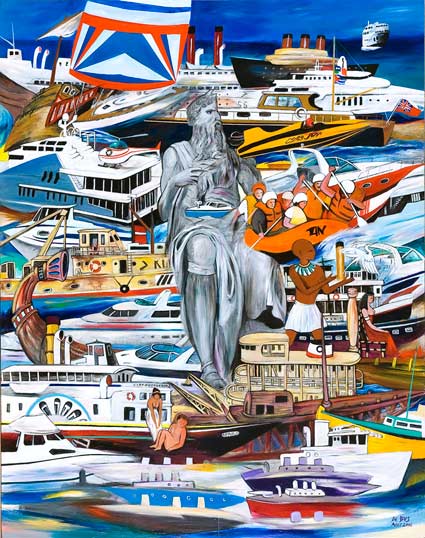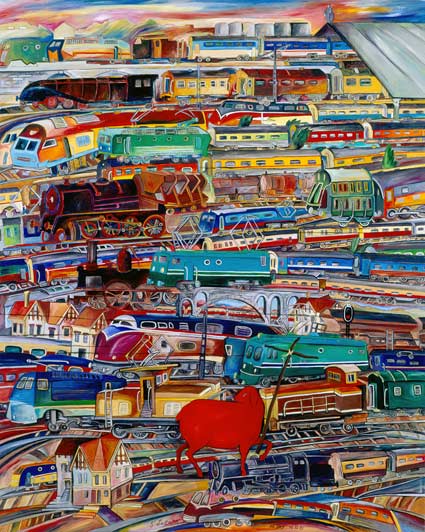Jean-François de Bus
The Modern Lamb
Spiritual great-grandson of the Flemish mystic painters, Jean-François de Bus is not an artist whose work is easy to tackle. Mixing, with surprising consistency, that which usually only has meaning through being the object of distinct representations (either of the secular world or the sacred world), his baroque compositions give us, in a style similar to that of Diego Riveras, a vision at once funny and profound of the contradictions that underlie our modernity.
The Modern Lamb
“The grass, in the streets of St. Petersbourg, is none other than the first sprouts of the jungle that is coming to recover the sites of modern cities. All this young verdure, bright and tender, remarkably fresh, belongs to a new spiritualized nature.” Ossip Mandelstam
Sometimes fascinated by speed and technology (the visual beauty of an airplane, a train, a building or bridge), sometimes by the biblical iconography or history of painting, that which gives value to the work of this painter-poet is not only linked to the richness of his graphic vocabulary, but also to how each of his paintings is able to deconstruct the meaning of the references within them— to assign to them a different place and meaning on the great chessboard of Western culture.
Therefore, if we had one word to define the style of Jean-François de Bus, we would be tempted to apply the term “structuralist.” For, as is quite evident, his approach to composition, based mainly on a brilliant use of syncopation and development of apposition, involves rethinking the meaning of the figures he uses depending on the place and relationships they hold amongst each other. Jean-François de Bus himself also confesses this, about one of his paintings (“Le temps des gentils”, “Time of the Gentiles”), when he writes: “In this upheaval, in this apparent chaos, civilization and memory remain, giving a vision of multiple intertwined worlds. In one movement I combine modernity and the remnants of the past.”


To this impression of “apparent chaos”—the syncretism of cultures—it is important to add that of an implicit order of references. For it is clear that for those who will take the time to examine the hundreds of events that confront each other in his paintings, (where coexisting, on equal footing, are all cultures and epochs), and those who will have the strength to let his or her imagination wander without prejudice wherever the colors and shapes of these works lead him, will surely find themselves in a kind of trance under the esoteric meaning of these compositions. But this meaning, what is it? Let’s risk, in closing our article, applying our own hypothesis.
Unlike painters of the Renaissance who were fond of integrating, inside of Christian iconography, representations of secular life, the goal of Jean-François de Bus is none other than to reintroduce, in the heart of neo-pop iconography, a spiritual dimension and, perhaps more profoundly, a religious one. Using symbols of sacred history (especially that of the divine Paraclete) as a veritable counter-point to the disorders of our times (his visual Apocalypse), these paintings aim to not only give us a representation of a modern Babylon, but also to share with us the principle of self-transcendence.
“Time of the Gentiles”, writes Jean-François de Bus, “is a story drawn on opulence, a poem about the tragicomedy of the human epic. But it is also the story of redemption.”
Translation by Cassandra Katsiaficas
Frédéric-Charles Baitinger
Jean-François de Bus
www.cridart.com/fr/fiche_artiste-205.html
